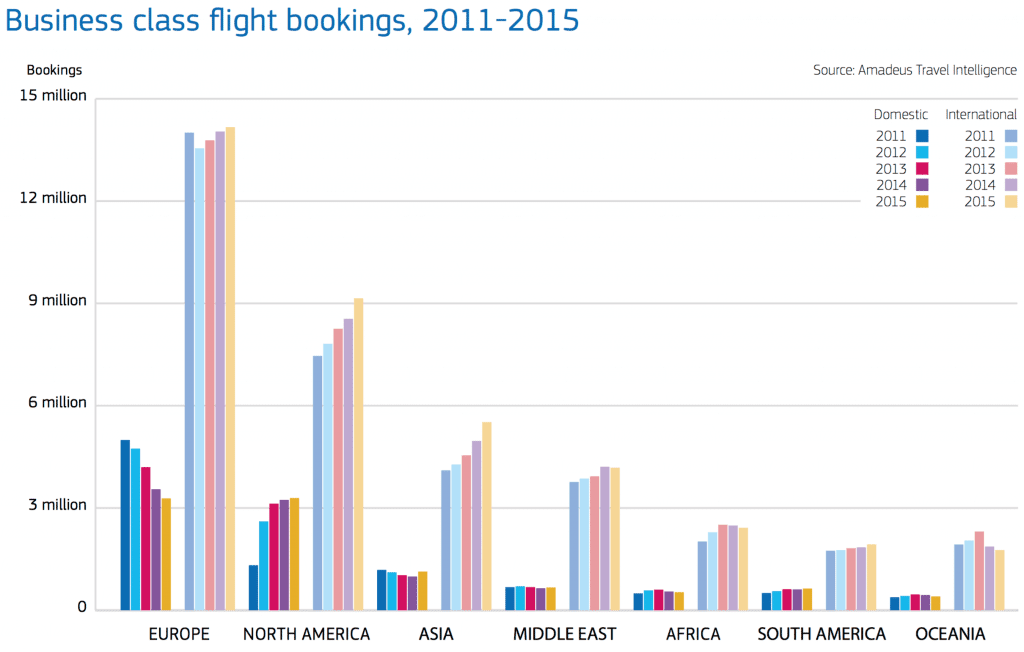Skift Take
Over the next decade, North America's dominance in luxury travel may be supplanted by Middle Eastern and Asian travelers looking to upgrade to a luxury travel experience.
Amadeus’ Shaping the Future of Luxury Travel report, prepared in conjunction with Tourism Economics, digs into booking data that shows Asia, North America, and the Middle East will see the biggest growth in luxury travel through 2025.
Overall, the report projects a 6.2 percent growth rate in luxury travel over the next decade, compared to 4.8 percent for travel in general.
While analysis shows the growth of Asia in luxury travel, the report is somewhat skeptical to about continued expansion in China itself.
“One thing to note is that China’s relatively mature luxury market is set against a backdrop of tightening regulations, where the government is applying pressure to tackle corruption,” reads the report. “This means that fewer people want to be perceived as ultra-rich and attract scrutiny – as illustrated by the nation’s declining private jet market. In other words, luxury travelers in China are more conscious about aunting their wealth, and will make travel choices accordingly.”
Here are four takeaways from Amadeus’ analysis of the luxury travel market and its growth through 2025.
Business class bookings are flat in Europe
Slow economic growth seems to have severely affected domestic business class flight bookings in Europe over the last five years. North America and Asia, however, are experiencing strong growth in international business class bookings.
More North Americans are booking first-class
When it comes to first-class flight bookings, North America leads both in both domestic and international categories. Most other regions are a mixed bag; Asian first-class bookings are down overall, while Europe saw slight growth in international
“This illustrates how U.S. domestic air travel continues to form a very high proportion of all global air travel, as well as the extreme maturity of the US luxury travel market when compared to other regions,” reads the report. “The fact that the number of first class flights has increased in the region illustrates how the wealthiest citizens of the world have not changed their travel patterns during the recession, and that the market has remained immune to austerity.”
Border and long-haul luxury is on the rise
It’s no surprise that long-haul luxury is the most popular type of luxury trip. The bulk of these trips are conducted by North American and European travelers.
“North America and Western Europe currently account for 64 percent of the world’s outbound luxury trips – despite only making up 18 percent of the global population,” according to the report. “This clear majority of the market share will continue over the next 10 years; the maturity of these luxury markets and the relative affluence of their populations explain this dominance.”
Luxury travel in South Asia is expected to grow the most
South Asia will experience the most travel growth through 2025, according to Tourism Economics’ research. North Africa and South America are expected to see the least growth.
“Interestingly, the luxury travel market in Northeast Asia, including China, is projected to grow at a fractionally slower rate than its overall travel [growth rate], albeit still at a healthy rate,” concludes the report. “This could again be down to China’s size and therefore dominance over market patterns – having already reached the point where its middle class is maturing and increasing in sophistication, it’s natural that the growth rate of its luxury market will slow a little. China’s middle class market is still comparatively new compared with North America’s and Europe’s – but unlike in India the ‘boom’ has already happened.”
The Daily Newsletter
Our daily coverage of the global travel industry. Written by editors and analysts from across Skift’s brands.
Have a confidential tip for Skift? Get in touch
Photo credit: Etihad Airways' First Apartment first-class product. North Americans are booking more premium products than travelers from other regions. Etihad Airways




